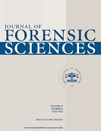Examination of Heterogeneous Crossing Sequences Between Toner and Rollerball Pen Strokes by Digital Microscopy and 3-D Laser Profilometry
Abstract
Abstract: The determination of line crossing sequences between rollerball pens and laser printers presents difficulties that may not be overcome using traditional techniques. This research aimed to study the potential of digital microscopy and 3-D laser profilometry to determine line crossing sequences between a toner and an aqueous ink line. Different paper types, rollerball pens, and writing pressure were tested. Correct opinions of the sequence were given for all case scenarios, using both techniques. When the toner was printed before the ink, a light reflection was observed in all crossing specimens, while this was never observed in the other sequence types. The 3-D laser profilometry, more time-consuming, presented the main advantage of providing quantitative results. The findings confirm the potential of the 3-D laser profilometry and demonstrate the efficiency of digital microscopy as a new technique for determining the sequence of line crossings involving rollerball pen ink and toner.




